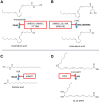A lipid gate for the peripheral control of pain
- PMID: 25392487
- PMCID: PMC4228127
- DOI: 10.1523/JNEUROSCI.3475-14.2014
A lipid gate for the peripheral control of pain
Abstract
Cells in injured and inflamed tissues produce a number of proalgesic lipid-derived mediators, which excite nociceptive neurons by activating selective G-protein-coupled receptors or ligand-gated ion channels. Recent work has shown that these proalgesic factors are counteracted by a distinct group of lipid molecules that lower nociceptor excitability and attenuate nociception in peripheral tissues. Analgesic lipid mediators include endogenous agonists of cannabinoid receptors (endocannabinoids), lipid-amide agonists of peroxisome proliferator-activated receptor-α, and products of oxidative metabolism of polyunsaturated fatty acids via cytochrome P450 and other enzyme pathways. Evidence indicates that these lipid messengers are produced and act at different stages of inflammation and the response to tissue injury, and may be part of a peripheral gating mechanism that regulates the access of nociceptive information to the spinal cord and the brain. Growing knowledge about this peripheral control system may be used to discover safer medicines for pain.
Copyright © 2014 the authors 0270-6474/14/3415184-08$15.00/0.
Conflict of interest statement
Conflicts of interest: D.P. and B.D.H. are inventors in issued patents and patent applications filed by the University of California and the Fondazione Istituto Italiano di Tecnologia, which disclose pharmaceutical agents targeting molecular pathways described in the present article. B.D.H. is a cofounder of Eicosis LLC, which develops soluble epoxide hydrolase inhibitors. D.P. is a cofounder of Anteana Therapeutics Inc, which develops endocannabinoid-based medications, and Thesan Pharmaceuticals Inc, which develops dermatological therapies unrelated to the topic of the present article. The remaining authors declare no competing financial interests.
Figures


References
-
- Agarwal N, Pacher P, Tegeder I, Amaya F, Constantin CE, Brenner GJ, Rubino T, Michalski CW, Marsicano G, Monory K, Mackie K, Marian C, Batkai S, Parolaro D, Fischer MJ, Reeh P, Kunos G, Kress M, Lutz B, Woolf CJ, et al. Cannabinoids mediate analgesia largely via peripheral type 1 cannabinoid receptors in nociceptors. Nat Neurosci. 2007;10:870–879. doi: 10.1038/nn1916. - DOI - PMC - PubMed
-
- Appiah KK, Blat Y, Robertson BJ, Pearce BC, Pedicord DL, Gentles RG, Yu XC, Mseeh F, Nguyen N, Swaffield JC, Harden DG, Westphal RS, Banks MN, O'Connell JC. Identification of small molecules that selectively inhibit diacylglycerol lipase-alpha activity. J Biomol Screen. 2014;19:595–605. doi: 10.1177/1087057113511111. - DOI - PubMed
Publication types
MeSH terms
Substances
Grants and funding
LinkOut - more resources
Full Text Sources
Other Literature Sources
Medical
